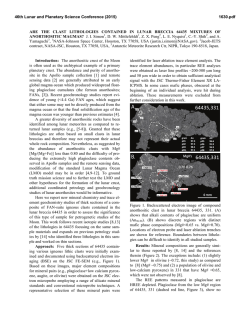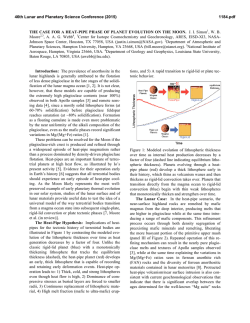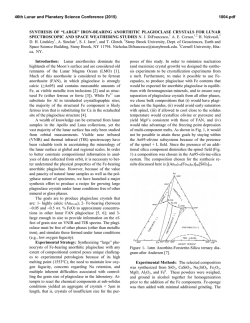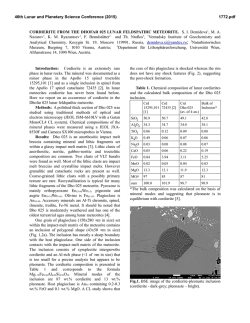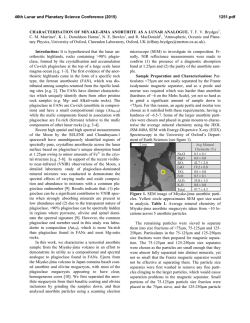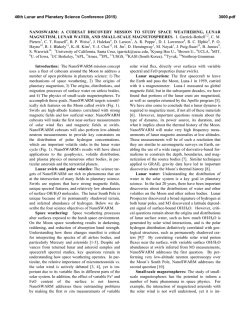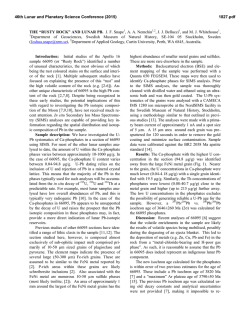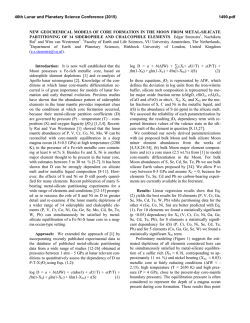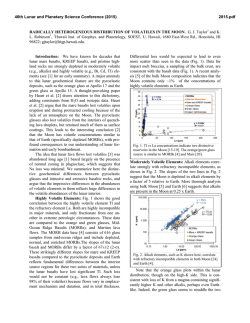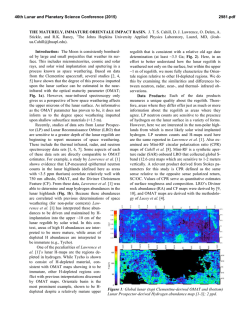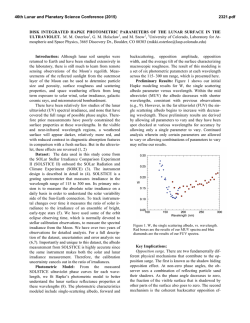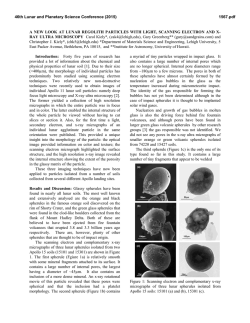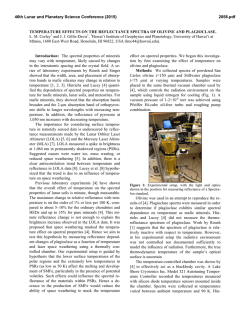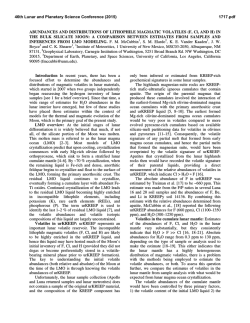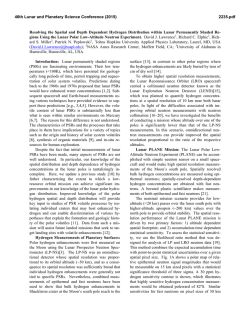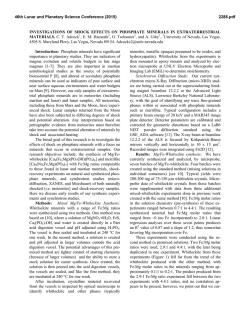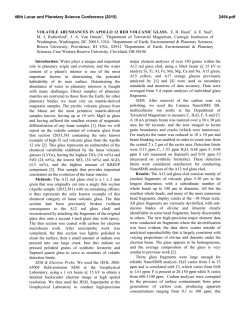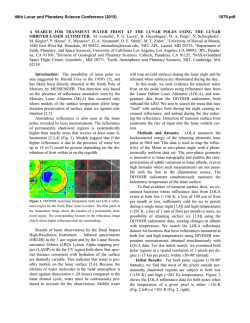
SIMS Analysis of Water Abundance and Hydrogen - USRA
46th Lunar and Planetary Science Conference (2015) 1927.pdf SIMS ANALYSIS OF WATER ABUNDANCE AND HYDROGEN ISOTOPE IN LUNAR HIGHLAND PLAGIOCLASE. Hejiu Hui1, Yunbin Guan2, Yang Chen2,3, Anne H. Peslier4, Youxue Zhang5, Yang Liu3, George R. Rossman2, John M. Eiler2, Clive R. Neal1, 1Department of Civil & Environmental Engineering & Earth Sciences, University of Notre Dame, Notre Dame, IN 46556, 2Division of Geological and Planetary Sciences, California Institute of Technology, Pasadena, CA 91125, 3Jet Propulsion Laboratory, California Institute of Technology, 4800 Oak Grove Dr, Pasadena, CA 91009, 4Jacobs, NASA-Johnson Space Center, Mail Code X13, Houston, TX 77058, 5 Department of Earth and Environmental Sciences, University of Michigan, Ann Arbor, MI 48109. Introduction: The detection of indigenous water in mare basaltic glass beads [1] has challenged the view established since the Apollo era of a “dry” Moon [2]. Since this discovery, measurements of water in lunar apatite [3-9], olivine-hosted melt inclusions [10], agglutinates [11], and nominally anhydrous minerals [12,13] have confirmed that lunar igneous materials contain water, implying that some parts of lunar mantle may have as much water as Earth’s upper mantle [10]. The interpretation of hydrogen (H) isotopes in lunar samples, however, is controversial. The large variation of H isotope ratios in lunar apatite (δD = -202 to +1010 ‰) has been taken as evidence that water in the lunar interior comes from the lunar mantle, solar wind protons, and/or comets [5]. The very low D/H ratios in lunar agglutinates indicate that solar wind protons have contributed to their hydrogen content [11]. Conversely, H isotopes in lunar volcanic glass beads and olivine-hosted melt inclusions being similar to those of common terrestrial igneous rocks, suggest a common origin for water in both Earth and Moon [14]. Lunar water could be inherited from carbonaceous chondrites [14], consistent with the model of late accretion of chondrite-type materials to the Moon as proposed by [15]. One complication about the sources of lunar water, is that geologic processes (e.g., late accretion and magmatic degassing) may have modified the H isotope signatures of lunar materials. Recent FTIR analyses have shown that plagioclases in lunar ferroan anorthosite contain ~6 ppm H2O [12]. So far, ferroan anorthosite is the only available lithology that is believed to be a primary product of the lunar magma ocean (LMO) [16]. A possible consequence is that the LMO could have contained up to ~320 ppm H2O. [12]. Here we examine the possible sources of water in the LMO through measurements of water abundances and H isotopes in plagioclase of two ferroan anorthosites and one troctolite from lunar highlands. Samples and Methods: The plagioclase grains for this study are from ferroan anorthosite 60015,787 and 15415,238, and troctolite 76535,164. These samples were described in [12]. One piece from a polished plagioclase grain (already analyzed using FTIR [12]) of each sample along with terrestrial plagioclase standards were embedded in an indium disc for electron probe microanalysis (EPMA) and secondary ion mass spectrometry (SIMS) analysis. To check and minimize the H background effect of the SIMS, we prepared two sets of plagioclase standards. One set includes four natural gem-quality plagioclase grains (An68-70, An96 [17], GRR2058, and GRR1968). The other set consists of three heated plagioclase grains (one piece each from An68-70, An96, and GRR2058), which have been dehydrated by heating to 1000 ºC for about two weeks in a high-purity N2 atmosphere at the University of Michigan and then cleaned with the same procedure as described in [12]. Therefore, these heated grains are assumed dry and any H detected in the heated grains is assumed to be background in the SIMS measurements. The sample disc was first carbon coated and the plagioclase grains were analyzed for major elements using a Cameca SX100 EMP at the University of Michigan. Before SIMS analysis, carbon coating on the samples was removed by gentle polishing, and the samples were cleaned and stored in the vacuum oven for about a week. Then, the plagioclase grains were coated with Au-Pd and analyzed with a Cameca ims-7f GEO ion probe at Caltech. To minimize H (and OH) backgrounds, the instrument was baked for 24 h and samples were kept in the sample storage chamber (~4×10-9 torr) for about a week prior to analysis. The vacuum for the sample chamber during analysis was ~2×10-10 torr. The OH background was assessed by analyzing the heated terrestrial plagioclase grains periodically (Fig. 1). A +10 keV Cs+ primary beam was used to sputter the sample. Secondary ions of -9 keV (12C-, 16OH-, 18O-, 19F-, 30Si-, 32S-, 35Cl-) were collected at a mass resolving power (MRP) of ~5500. Calibration for H2O concentration was done with the heated and two natural plagioclases (H2O: 0 ppm in the heated grains; ~1 ppm in GRR2058; ~70 ppm in GRR1968, G.R. Rossman, personal communication). Hydrogen isotope analysis was performed following H2O concentration measurement, by collecting H- and D- at a lower MRP (~1200). Because there is no available H isotope standard for plagioclase, we assume that the δD value of GRR1968 (megacryst from alkali basalt) is -100±40 46th Lunar and Planetary Science Conference (2015) ‰, a typical mantle value [18]. This assumption is reasonable and accurate enough for the purpose of our study, because most of the uncertainties in the H isotopic results of lunar plagioclases are from other sources (see below). Hydrogen isotopic ratios of lunar plagioclases were corrected for instrumental background, instrumental mass fractionation, and cosmic rayEffects spallation. of Heat Treatment -- OH 2.0E-03 blue – heated red – unheated OH-/30Si- 1.6E-03 1.2E-03 8.0E-04 4.0E-04 0.0E+00 An68-70 An96 GRR2058 Fig. 1. Comparison of OH in three natural terrestrial plagioclase grains and heated grains. Fig. 2. Hydrogen isotope compositions of lunar samples (76535 plagioclase, 15415 plagioclase, 60015 plagioclase, 14305 apatite [5], and 74220 melt inclusion [14]) and terrestrial plagioclases (An96 and An6870). The dashed lines show the δD range of terrestrial mantle minerals [18]. SIMS Results and Discussion: The terrestrial plagioclase An96 has about 6 to 8 ppm water and An6878 has about 8 to 11 ppm water with some fluorine. Its δD is also different from the other two terrestrial plagioclases. An96 has a δD value of about -70±90 ‰, within the error of GRR 1968. However, An68-70 has a much higher δD value, about +150±50 ‰. This shows that An68-70, purchased online without source information, may not have an origin similar to that of An96 and GRR1968 as indicated by its high F concentration and δD (Fig. 2). SIMS results show that the lunar plagioclase grains of ferroan anorthosite 60015 and 15415, and troctolite 76535 contain ~3 to ~6 ppm H2O, consistent with pre- 1927.pdf vious FTIR analysis [12]. Therefore, these independent analyses have confirmed that Moon contained water at the time of crystallization of the LMO. Hydrogen isotope ratios in lunar highland plagioclases are significantly higher than those in terrestrial mantle plagioclases. After the correction for cosmogenic production following the procedure of [14], the H isotopic data for 76535 and 15415, which have cosmic ray exposure (CRE) ages of ~233 Ma [19] and ~104 Ma [20], respectively, do not have much meaning due to the large associated uncertainties. However, because ferroan anorthosite 60015 has a relatively short (~10 Ma) CRE age [21], the cosmic ray spallation correction for H isotope ratio is small (Fig. 2). It has also been suggested that water in this plagioclase grain unlikely has been affected by solar implantation [12]. Therefore, its δD value (+260±110 ‰) is considered reliable. This δD value is consistent with those in lunar olivine-hosted melt inclusion (+187 ‰) with 1200 ppm water [14] and in apatite (+238 and +341 ‰) from a 3.9-Ga lunar alkali anorthosite 14305,303 [5]. Combining these results, the lunar mantle likely has a δD value that is higher than those of nominally anhydrous minerals (-92 to -113 ‰) from Earth’s upper mantle [18] by about 300 ‰ (Fig. 2). The higher δD value of the lunar interior compared to that of Earth’s upper mantle could have resulted either from the degassing of the LMO, or the contribution of different H isotope ratio of the giant impactor Theia, or from accretion during its molten state. References: [1] Saal A. E. et al. (2008) Nature, 454, 192-195. [2] Lucey P. et al. (2006) Rev. Mineral. Geochem., 60, 82-219. [3] Boyce J. W. et al. (2010) Nature, 466, 466- 469. [4] McCubbin F. M. et al. (2010) PNAS, 107, 11223-11228. [5] Greenwood J. P. et al. (2011) Nature Geosci., 4, 79-82. [6] Barnes J. J. et al. (2013) CG, 337-338, 48-55. [7] Tartèse R. et al. (2013) GCA, 122, 58-74. [8] Barnes J. J. et al. (2014) EPSL, 390, 244-252. [9] Tartèse R. et al. (2014) Geology, 42, 363-366. [10] Hauri E. H. et al. (2011) Science, 333, 213-215. [11] Liu Y. et al. (2012) Nature Geosci., 5, 779-782. [12] Hui H. et al. (2013) Nature Geosci., 6, 177-180. [13] Liu Y. et al. (2012) LPSC, 43rd, 1866. [14] Saal A. E. et al. (2013) Science, 340, 1317-1320. [15] Tartèse R. and Anand M. (2013) EPSL, 361, 480486. [16] Shearer C. K. et al. (2006) Rev. Mineral. Geochem., 60, 365-518. [17] Waythomas C. F. et al. (2010) JGR, 115, B00B06. [18] Bell D. R. and Ihinger P. D. (2000) GCA, 64, 2109-2118. [19] Lugmair G. W. et al. (1976) PLSC, 7th, 2009-2033. [20] Eugster O. et al. (1984) PLPSC, 14th, B498-B512. [21] Hörz F. et al. (1975) PLSC, 6th, 3495-3508.
© Copyright 2025
